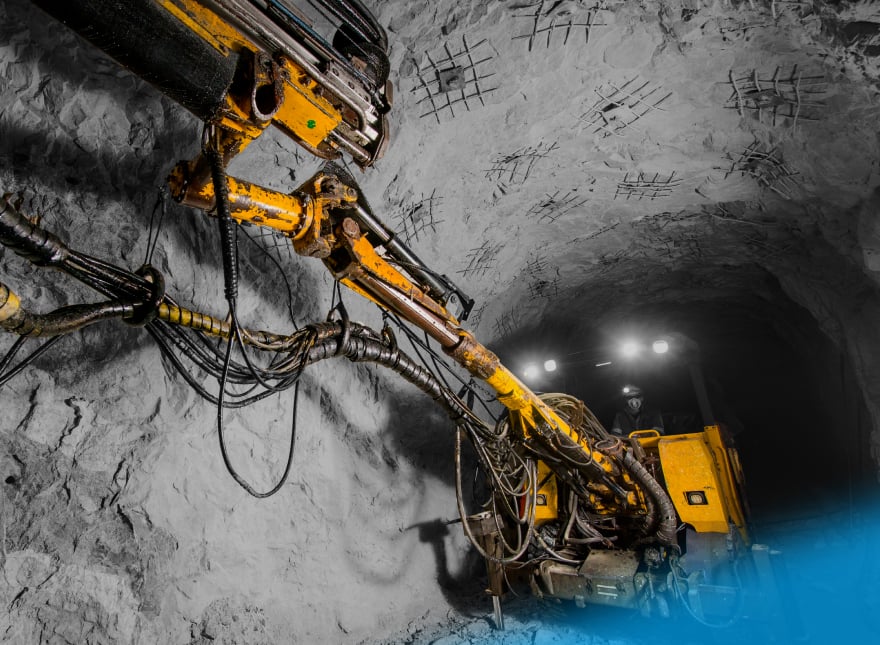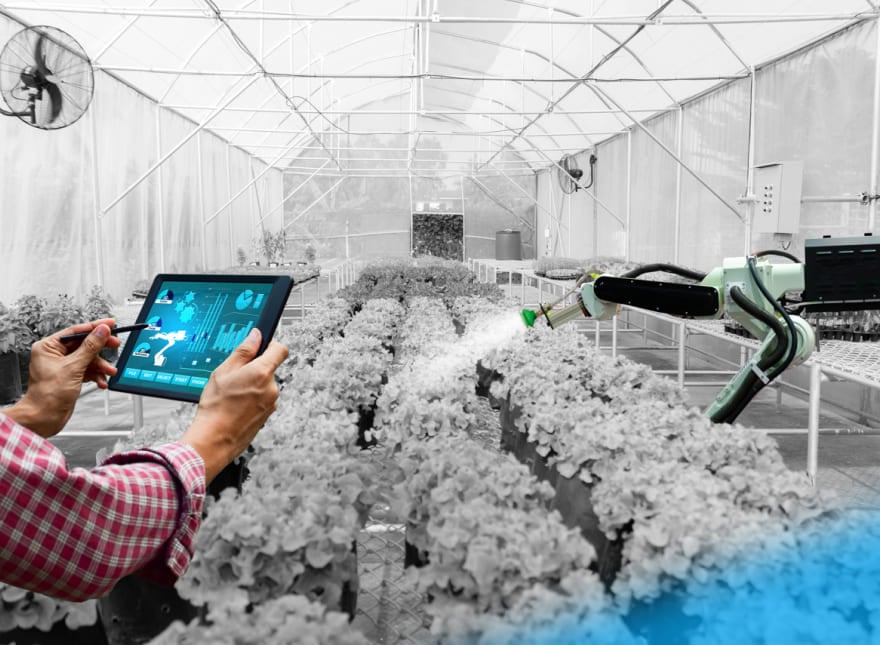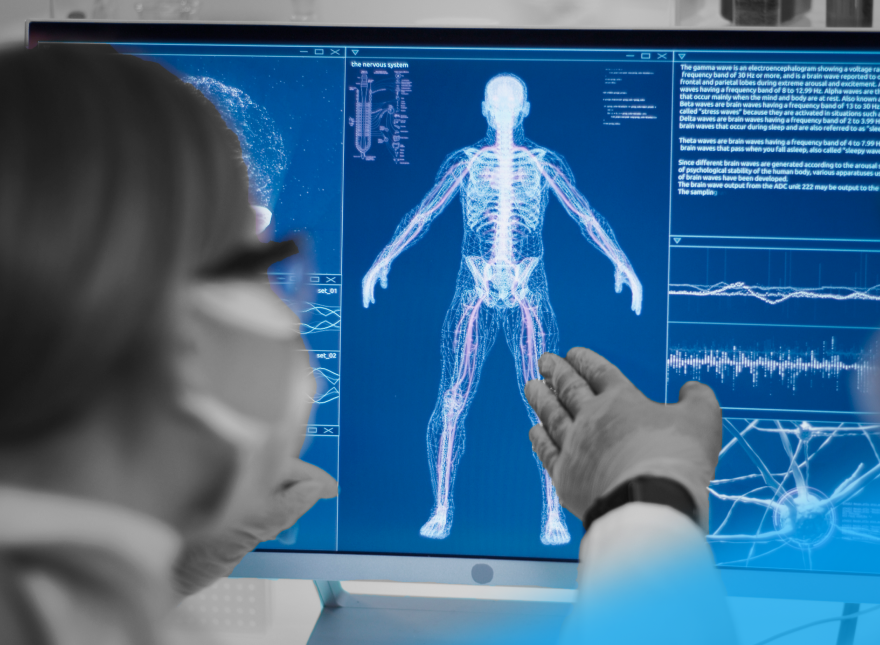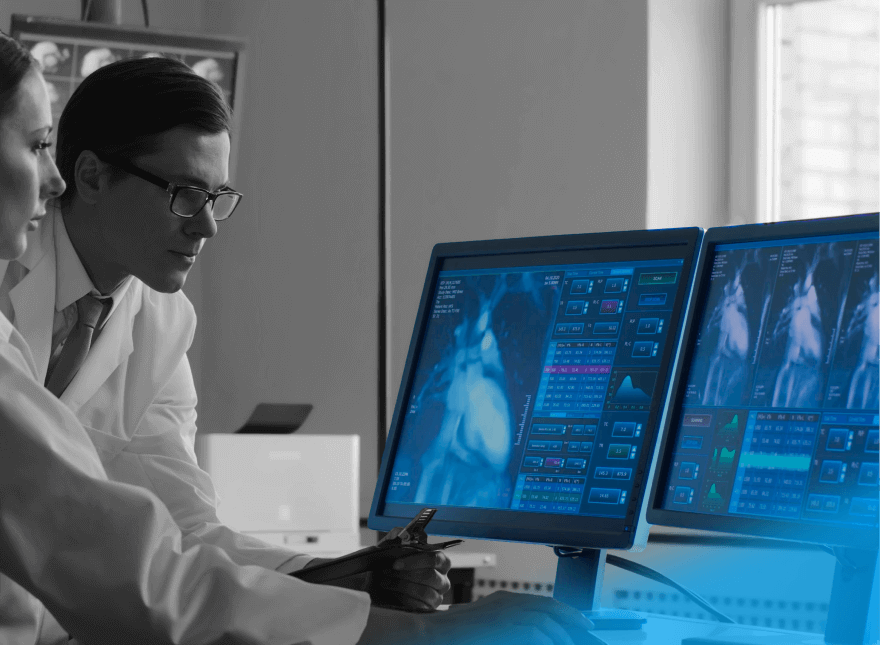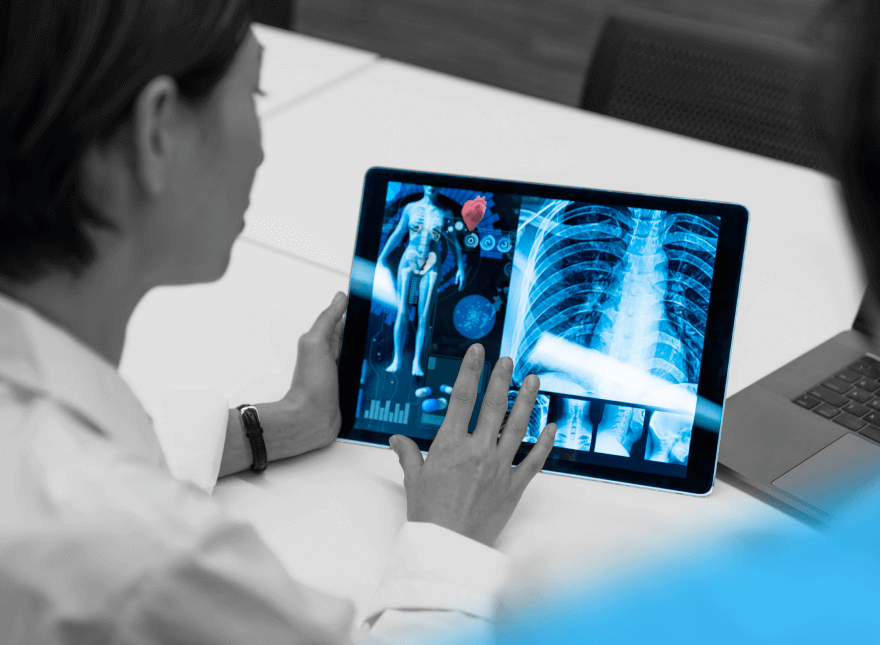3 Types of AR Applications Disrupting the Automotive Industry
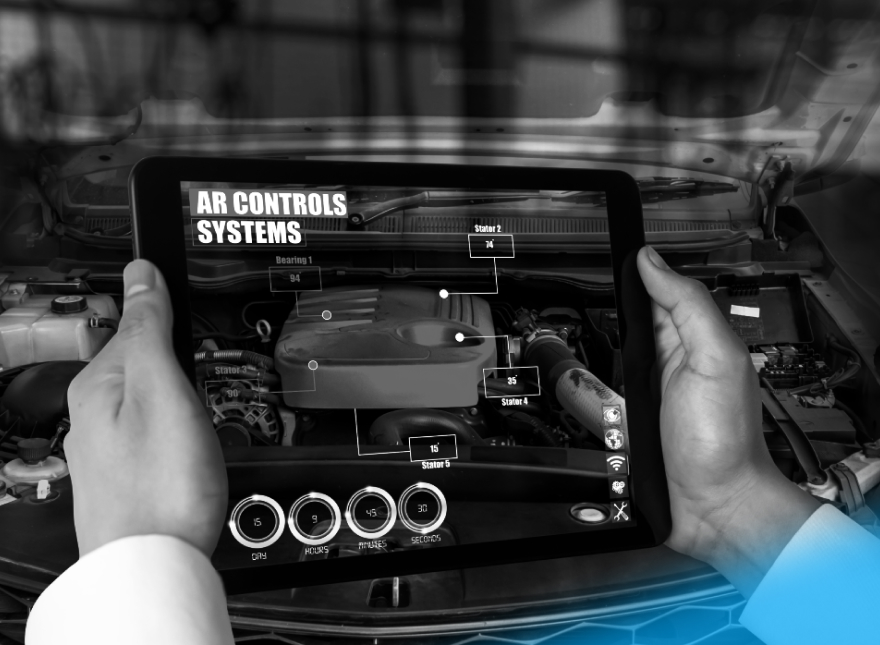
We all drive. Imagine a car dashboard showing you an unfamiliar alert. What would you do? The classic response is to look through a multi-page paper manual or call a mechanic... or maybe even ignore it. But is there anything safer and more convenient? There is: placing your smartphone camera in front of the alert and getting an immediate answer. AR makes this possible by augmenting physical-world experience with data and graphics.
Not only car owners benefit from AR, but the entire automotive sector: augmented reality brings new opportunities at every step of the process chain. It helps in manufacturing and inventory, assists technicians in vehicle maintenance, and boosts systems for a better driving experience. Take a look at the benefits that AR-based solutions bring to the automotive industry and companies working for it.
Table of Contents
How AR Augments Automotive Reality
AR has the ability to add robust capabilities to solutions across multiple modalities—visual, auditory, haptic, somatosensory, and olfactory. In the automotive sector, visual forms of augmented reality—via screens or glasses—prevail. For example, AR in automotive contributes to creating various types of head-up displays (HUDs) for applications.
So what does AR bring and why do so many carmakers invest their funds and efforts into this technology? Unlike expensive virtual reality, which has to generate the entire environment, much more affordable augmented reality only enhances the physical world with virtual elements. AR places 3D models into real situations and adds context to a display.
It’s possible to embed 3D models into the digital world with the help of either markers or sensors.
- Markers. When using marker-based solutions, merging real and virtual environments is built on a camera that extracts features from markers—images, QR codes, or physical objects. Using AR to retrieve car parts in a warehouse is an example of how this plays out in the automotive industry.
- Sensors. Sensor-based solutions, in turn, rely on the exact camera position related to a real-world object. Technologies like GPS, RFID, and Wi-Fi are here to help define the location. This option is the best choice for scenarios where safety is a top priority, like the AR-assisted dashboard controlling road conditions and surroundings.
For both sensors and markers, it’s necessary to train deep learning algorithms for accurate detection of objects in live data.
What AR Brings to Automotive: Practical Use Cases
Take a look at the real-life examples of automotive solutions and what perspectives it brings to OEMs, suppliers, software development companies, startups, and drivers.
Enhanced Driver Experience
New safety standards as well as an ever-increasing demand for comfort and luxury propel the automotive market. Industry 4.0 additionally calls for sustainability and consideration of future impact. So it’s no surprise that vehicles are becoming more complex and sophisticated year after year. Imagine a modern car. It incorporates multiple cameras, dozens of sensors, microprocessors, and about 100 million lines of code. Infotainment systems connected to the cloud make the vehicles of today technological marvels on wheels.
Augmented reality, in turn, is here to improve navigation and infotainment systems and enhance vehicle safety. For instance, it can augment navigation, adaptive cruise control, and lane departure warning. Other examples include AR-assisted dashboards, real-time street signs and accident warning, and AR entertainment systems. As a result, drivers get instant information on the surrounding environment and road conditions.
Real-Life Example: 3D-powered Augmented Reality Interface
The invisible-to-visible technology (I2V) from Nissan introduces a 3D space around a vehicle. It enables an AR-assisted interface that was first presented at CES 2019. The idea is to provide drivers with real-time road data and make manual navigation assistance smarter and safer. Data from the vehicles shows hidden hazards or unforeseen traffic situations.
Benefits
The use of augmented reality in automotive settings advances the driving experience, so automakers can:
- Improve product quality—build solutions that enhance navigation, comfort, and entertainment, providing better services for customers
- Increase sales, providing top-notch functionality in line with the latest tech trends
- Get a leg up on the competition
Presentation Guides and Car Manuals
Augmented reality applications used in showrooms help salespeople show car functionality with the help of a headset or smartphone camera. The technology allows for a visualization of lots of overlapping information, such as interior and exterior parts, performance, weight, and financing. It’s possible to present this data in an interactive way and keep it up to date on the go.
AR-powered guides and instructions easily replace long and complex manuals. Manual applications provide car owners with access to vehicle features, maintenance, and information for repairs via smartphone or tablet.
Real-Life Example: Genesis Virtual Guide
AR-powered virtual guide app from Hyundai is a vivid example. At first, the application appeared to recognize about fifty vehicle features of the 2015 and 2016 Sonata. Today, it supports Genesis luxury sedans that use augmented reality. With this guide, consumers get how-to information for repairs, maintenance, and vehicle exterior and engine parts. 2D and 3D tracking technologies allow the delivery of in-depth information related to specific parts.
Benefits
Here are some perks of augmented reality applications in the automotive industry for guides and instructions:
- More efficient and cost-saving demonstrations in showrooms and sales
- Increasing brand awareness by making car demos eye-catching
- Driving sales, offering handy, easy-to-use applications instead of complex, old-school manuals
- Providing better services for customers with interactive manuals that can prevent them from visiting a service center or car mechanic, ensuring a more efficient diagnosis and repair process
Product Development and Maintenance
Augmented reality improves manufacturing and inspection operations on the factory floor. Spatial AR applications assist designers in matching various design options to physical vehicle models. Technicians can receive documentation and instructions in their AR glasses without being distracted. AR-guided part locating helps warehouse employees become faster and more efficient.
AR is also helpful for vehicle maintenance. Instead of a monotonous manual search, technical workers can use AR devices to identify machines and equipment that need service, simply by checking their data and history.
Training factory workers with AR is another powerful perk. Augmented reality coupled with digital twin technology can introduce virtual clones of physical assets, which help automate the training process in manufacturing. These digital models facilitate the training process—employees can see internal components to learn how to repair and service vehicles. An example of this is an iPad training app created by Jaguar Land Rover in tandem with Bosch.
Real-Life Example: AR Manufacturing Environment
BMW is among the early adopters of AR on the factory floor. The company uses augmented reality to inspect delivered tools at its Toolmaking and Plant Engineering units in Munich, Germany. The AR-assisted app helps technicians get related data about each tool—its drill holes and clear surface features—before using it. Algorithms overlay each taken image with around 50 criteria. If a tool doesn’t meet the specifications, there is a chance to rework it before sending it to the assembly area.
Benefits
In manufacturing, AR applications assist technicians in developing and maintaining cars in many ways:
- Optimizing assembly process with AR images of vehicle parts or technical information on AR glasses
- Saving operational costs by reducing the price of design and prototyping
- Boosting the productivity and efficiency of product development with automated processes for storing parts and equipment like AR-guided warehouse locating
- Automating the worker training process, allowing them to repair a vehicle without removing parts
- Shortening production time by using AR to automate routines on the factory floor
Prospects of AR in the Automotive Industry
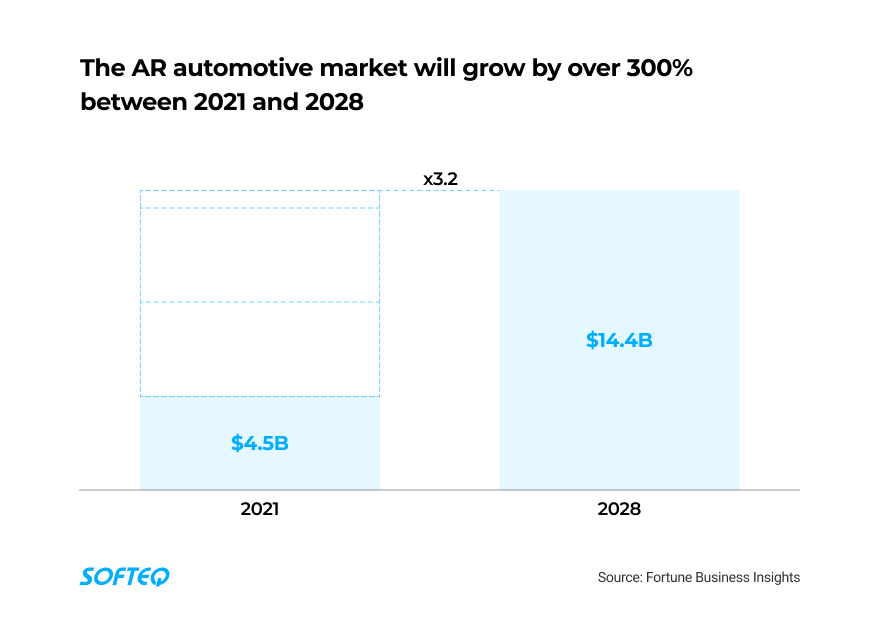
Many major OEMs have already ramped up their efforts with AR applications. They help both manufacturers and users. Tesla patented a Google Glass-like AR system for faster and more accurate vehicle production. Luxury cars from Mercedes, BMW, and Genesis are fitted with AR heads-up displays (HUDs) to boost the driver experience. For example, the 2022 Mercedes-Benz EQS comes with a rich color HUD. It projects 3D direction arrows in the driver’s field of vision for turn-by-turn navigation. The feature adds to the car’s autonomous capabilities and driver assistance.
Each year, AR HUDs become larger, crisper, and more data-rich. According to Fortune Business Insights, they will become the largest AR automotive market segment in the future. And this isn’t surprising given that they not only improve user experience but may also help the driver in difficult traffic conditions. A heads-up display with AR communicates with the car’s systems and projects information in the driver’s line of sight. Drivers get assistance without even shifting their eyes from the traffic, which makes roads safer.
One of the most important underlying technologies that enable AR HUDs is sensor fusion. It merges data from various sensors like radars, lidars, and cameras to create a full picture of the environment around a vehicle. This technology makes use of each sensor type’s strengths. For example, cameras are good at reading signs, while radars are strong at detecting speed and distance. Sensor fusion makes critical safety apps more accurate and vehicles generally smarter.
The AR automotive market can be segmented by technologies, functions, and the level of autonomous driving.
.jpg?width=880&name=AR-automotive-market-can-be-segmented-by-technologies_(1).jpg)
Bottom Line
High safety standards, innovative competitors, and novel regulations in times of industry 4.0 require OEMs, their suppliers, and startups to invest in safer driving experiences by creating more digitalized vehicle features and more complex cars in general. Along with IoT, AI, computer vision, and cloud technologies, augmented reality helps develop truly smart connected vehicles. The technology supports driving, as well as tasks on the auto manufacturing factory floor, thus delivering competitive solutions better and faster. Softeq is here to help you implement AR capabilities for your automotive solution.
More articles on the topic

